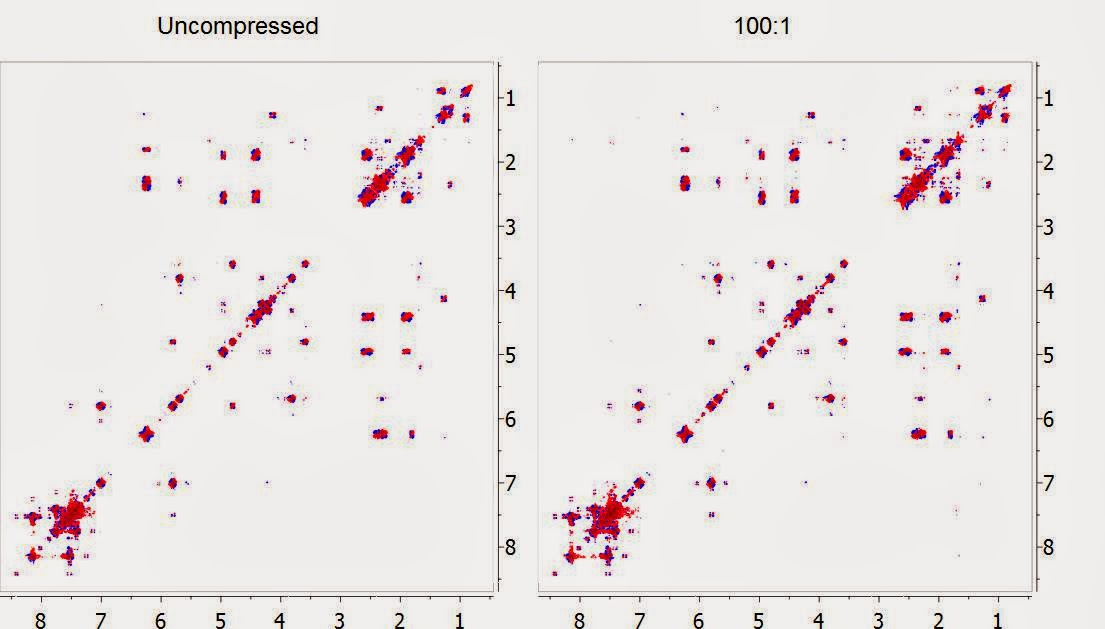
The partially saturated protons are unable to transfer as much polarization to the 15N as they would were they fully polarized. Attenuated 15N INEPT signals are observed when the protons (with short T 1) coupled to 15N exchange with those of water (longer T 1) on a time scale of seconds.* The problem arises because of saturation transfer during the inverse gated decoupling used during the acquisition time.

There are, however cases where 15N INEPT signals are attenuated or entirely nonexistent. These two factors mean that the true time saving for a 15N INEPT measurement compared to a one-pulse 15N measurement can be on the order of 100 - 1000 times. 1H T 1's are typically an order of magnitude (or more) less than those of 15N so the recycle delays required for 15N INEPT spectra are at least ten (and possibly 100 times) shorter than those required for one-pulse data collection. Furthermore, the recycle delay for the INEPT sequence depends on the the 1H T 1 relaxation time rather than that of 15N. In the case of 15N INEPT, the enhancement for each scan can be as much as γ H/γ N (~ 10) compared to that from a conventional one-pulse sequence with inverse gated decoupling. The pulse sequences incorporate delays based on the reciprocal of the J-coupling constant between the protons and the low γ nuclide. The enhancement relies on polarization transfer between the protons J-coupled and the low γ nuclide. INEPT and DEPT sequences are routinely used to enhance the NMR signals for low γ nuclides such as 15N or 13C. This modification to the CPMAS experiment is shown in the figure below. After the 1H spin locking pulse, cross polarization is applied, transferring polarization from the remaining API 1H magnetization to the API 13C. One can modify the simple CPMAS pulse sequence to discriminate against the excipients with short 1H T 1ρ's by introducing an additional 1H spin locking pulse before the cross polarization during which the transverse 1H magnetization of the excpient decays to zero while that of the API decays to a much smaller extent. Crystalline API compounds often have much longer 1H T 1ρ's than the amorphous excipient compounds. This can sometimes be accomplished by collecting spectra with differing recycle delays, as the excipients often have shorter 1H T 1relaxation times than the crystalline API. When analyzing pharmaceutical pills by solid-state 13C CPMAS NMR, one often wants to observe the active crystalline API and not the amorphous non-active excipients. Often the API is a crystalline compound while the excipients are noncrystalline or amorphous. This is illustrated in the figure below.Īctive pharmaceutical ingredients (API's) are often mixed with other compounds (excipients) used to dilute, stabilize, sweeten, color, flavour, bind, coat (etc.) the medication. This interaction is absent in the 12C isotopologue and one would therefore expect the T 1 relaxation time of 13CHCl 3 to be much shorter than that of 12CHCl 3.

For the 13C isotopologue of chloroform, one would expect a significant heteronuclear dipolar interaction between the directly bound 1H and 13C. One of these mechanisms is the result of the heteronuclear dipolar coupling interaction. For chloroform, with only a single proton, there can be no intra-molecular homonuclear 1H dipolar interaction and the 1H relaxation rate must depend on other mechanisms. Often, in proton-rich organic compounds, 1H T 1 relaxation is dominated by the homonuclear dipolar coupling interaction. Each of these mechanisms of relaxation depends on dynamic effects and the extent to which those processes occur at the Larmor frequency. homonuclear dipolar coupling, heteronuclear dipolar coupling, chemical shielding anisotropy, spin rotation etc.). The relaxation rate for any proton is the sum of relaxation rates resulting from several different mechanisms (eg. What is the 1H T 1 relaxation time of chloroform? It seems like a simple enough question, but the answer is not so simple.


 0 kommentar(er)
0 kommentar(er)
